Architecting HP FlexNetwork Solutions v6.6
Question 1
Which Flex Fabric product extends HP switch features to virtual hosts and extends HP
VAN Connection Manager benefits to virtualized environments'?
- A. HP Virtual Connect Manager
- B. HP 5900v Virtual Switch
- C. HP MSR 2000 router
- D. HP Virtual Cloud Networks
Answer : B
Question 2
Refer to the exhibit.
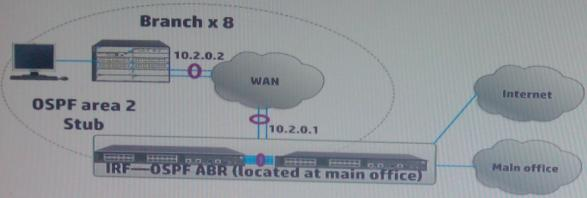
The customer requirements include resilience for branch communications. If anyone link fails, a branch can still reach the main office servers. In addition either one of the 5920 switches at the core of the WAN should be able to fail with branches still maintaining their connections.
What should the network architect include in the design to meet this requirement?
- A. A connection directly to an ISP to each branch router, which also requires the OSPF area to become a not so stubby area (NSSA)
- B. Virtual Router Redundancy Protocol (VRRP) enabled and configured in the switches in the 5920 IRF group
- C. Graceful restart on the 5920 IRF group in standard IETF mode
- D. A floating static route on the branch switches to the 5920 IRF group in case the OSPF solution fails
Answer : A
Question 3
Refer to the exhibits.
Exhibit 1 -
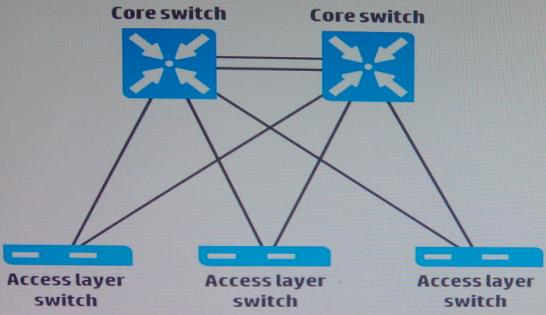
Exhibit 2 -
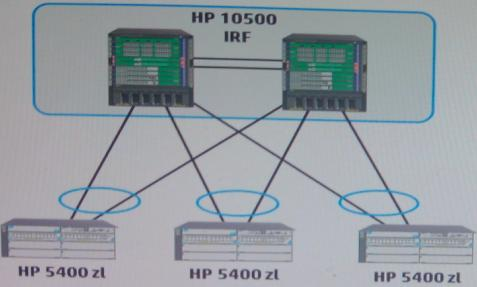
A customer has a existing solution, which is shown in Exhibit 1. (The solution actually includes more access layer switches than shown) in the existing solution, each access layer switch routes traffic.
A network architect is proposing the HP FlexCampus solution shown in exhibit 2 in this proposed solution, the core intelligent Resilient Framework (IRF) virtual switch routes traffic, but the access layer switches do not.
The customer likes that in the existing solution STP does not block either access layer uplink. The customer also likes that the existing solution does not require Virtual Router
Redundancy Protocol (VRRP).
What should the architect tell the customer about the benefits of the proposed solution?
- A. Although the IRF core must implement VRRP, STP does not block either access layer uplink, letting failover occur more quickly
- B. STP does not block either access layer uplink, and routing redundancy is provided without VRRP
- C. Although the IRF core must implement VRRP, VRRP is easier to set up than a dynamic routing protocol on all the switches
- D. STP will block one uplink on each access layer switch, but IRF enables failover to occur much more quickly
Answer : D
Question 4
A network architect is designing a redundancy solution for a customer and has learned that there is a single link between two critical network components. During the past 4000 hours of operation, the link has failed twice. The customer estimates that each failure has taken two hours to resolve.
Given this information, what is the availability that this link currently provides?
- A. Less than 99.99%
- B. 99.9%
- C. 99.99%
- D. 99.999%
Answer : B
Question 5
A customer prefers fixed-port switches at the campus access layer. The network architect wants to propose access layer switches simplifying network architecture and network management.
Which technologies should the network architect consider? (Select two.)
- A. Multiple Protocol Label Switching (MPLS)
- B. Virtual Routing and Forwarding (VRF)
- C. Intelligent Resilient Framework (IRF)
- D. Backplane stacking
- E. Net Stream
Answer : CD
Question 6
A network architect is planning a complete access layer and core upgrade for customers campus LAN. The campus has four large buildings, each requiring between 1000 and 3000 edge ports. Which factor will play a primary role in determining whether the network architect needs to plan a two-tier or three-tier topology for the campus LAN?
- A. The number of fiber links between each building and the building where the core switches reside
- B. Whether the customer requires a wireless solution
- C. The high number of edge ports that the solution requires
- D. Whether the customer can afford core switches that support intelligent Resilient Framework (IRF)
Answer : C
Question 7
A network architect has collected data on link utilization. When analyzing link utilization, what is the general guideline?
- A. You upgrade a link that is often used at more than 50 percent utilization
- B. You upgrade a link when it reaches 100 percent utilization
- C. You upgrade a link if it sometimes peaks at more than 50 percent utilization
- D. You upgrade a link when it reaches 25 to 30 percent utilization
Answer : A
Question 8
A network architect is designing a solution for a customer who wants better security on edge ports. Recently, an unauthorized individual was able to connect a snooping device to an open port (in other words, to a switch port that is active but not connected to a customer device). The customer wants to prevent this from happening again. However, the customer wants to avoid implementing 802.1X on ports because the IT staff is not prepared to deploy and manage such a solution.
What is the simplest way to minimize the risk of another unauthorized connection without adding a lot of management overhead?
- A. Place open ports in a VLAN that is not carried on uplinks.
- B. Implement MAC lockdown (as opposed to MAC authentication) on all open ports.
- C. Apply MAC authentication to the open ports and allow only known MAC addresses
- D. Apply dynamic port access control lists (ACLs) to open ports.
Answer : A
Question 9

The network architect is designing an Open Shortest Path First (OSPF) solution and plans to run OSPF on each of the VLAN in switches.
Based on the practices, which interface or interfaces should the network architect plan the features on?
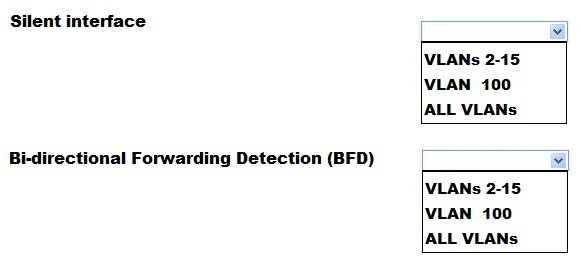
Answer : 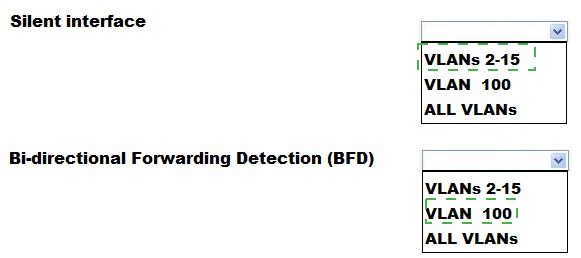
Explanation:
Silent Interface VLANs 2-15 -
Bi-directional Forwarding Detection (BFD) VLAN 100
Question 10

A company has several branch offers, each of which has four VLANs: one for employees, one for guests, one for network infrastructure local services. At each office, a VLAN has a maximum of 200 endpoints. Each branch office represents one Open Shortest path First
(OSP) architect has created the plan shown in the exhibit for IP addressing.
What is a potential disadvantage of this design?
- A. The subnets are large enough to accommodate fewer endpoints. But not large enough to accommodate 200 end points
- B. It makes it more complicated for the company to add subnets to branches in the future.
- C. The scheme uses private network addressing space, which is not permitted for use with OSPF.
- D. The address blocks do not provide enough IP addresses for the devices currently at each branch.
Answer : B
Question 11
HP data center access layer can use top of rack (ToR) switches or End of Row (EoR)/
Middle of Row (MoR) switches. Select the design with advantage.
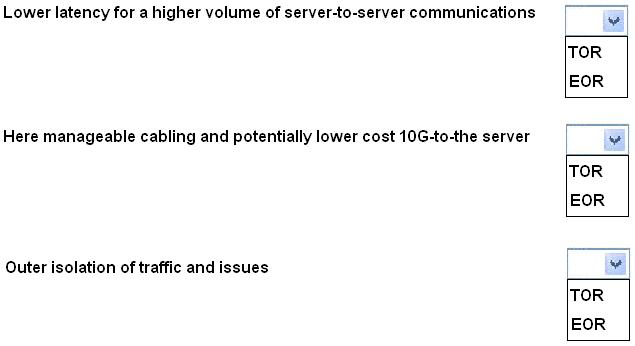
Answer : 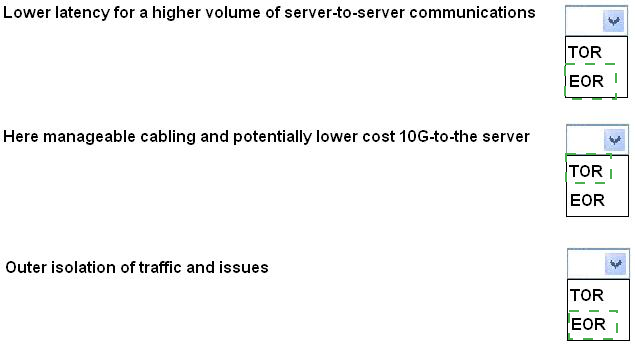
Explanation:
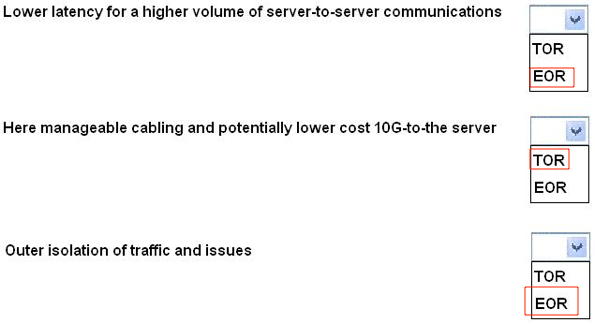
Rahail HDD:private:var:folders:8r:7tmxbm_x3151ngvr7gsng4cr0000gn:T:DMD86D05E80-
[6]
Question 12
Which description best characterizes current trends in deploying services for an enterprise?
- A. Companies are connecting multiple sites together but distributing services to each site to increase resiliency and responsiveness.
- B. Companies are moving services out of the private cloud into more responsive pods that are distributed throughout the campus LAN.
- C. Companies are transforming their campus LAN and data centers into one large Layer 2 network
- D. Companies are centralizing services in a consolidated data center or even a highly scalable private cloud
Answer : A
Question 13
A customer plans to connect 40 Voice over IP (VoIP) phones and 8 security cameras to a switch:
-> The VoIP phones are Class 2 PoE devices and require a maximum of 45W (draw a maximum of 5w)
-> The security cameras are Class 4 PoE+ devices and require a maximum of 17W
(draw a maximum of 20 W)
-> The network architect is proposing an HP 5500-48G-PoE switch, which supports
PoE and PoE+ and has a PoE power budget of 370W
-> The customer and architect agree on the class form of power allocation
What else does the solution require?
- A. A management module that is PoE+ capable
- B. A redundant power supply for the switch that enhances the PoE/PoE+ budget
- C. A power converter that enables the switch to provide PoE and PoE+ power at the same time
- D. A 208-220V input power service
Answer : A
Question 14
Refer to the exhibit.
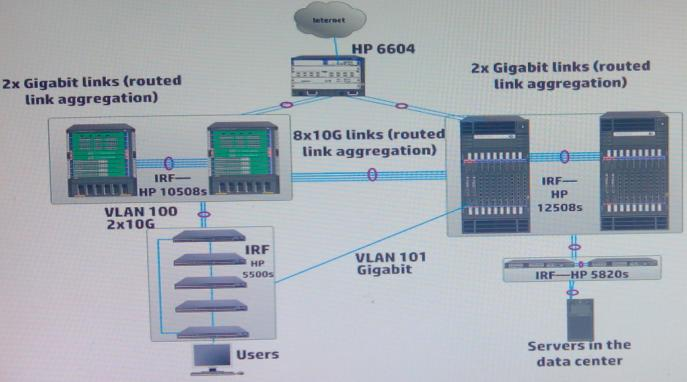
The exhibit shows the topology for an enterprise LAN with an on-site data center. The intelligent Resilient Framework (IRF) group of HP 5500 Series switches supports a group of computers that require very high availability to the data center. Therefore, the customer has requested a backup gigabit fiber link implement Open Shortest Path First (OSPF) in a single area.
Which tasks should the network architect complete to ensure that the HP 5500 IRF group selects the correct path to the data center during normal operation?
- A. Change the reference bandwidth on the VLAN 100 interfaces to 20000
- B. Set the cost on the VLAN 100 interfaces to 2 Set the cost for the VLAN 101 interfaces to 80
- C. Change the reference bandwidth on the VLAN 101 interfaces to 1000
- D. Change the VLAN 101 interfaces as silent interfaces
- E. Change the reference bandwidth to 80000 on all routing devices
Answer : B
Question 15
A network architect is choosing transceivers for switches-to-switches fiber links. Which factors affect the architects choice?
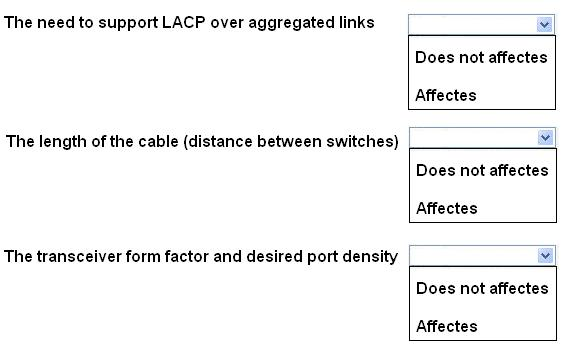
Answer : 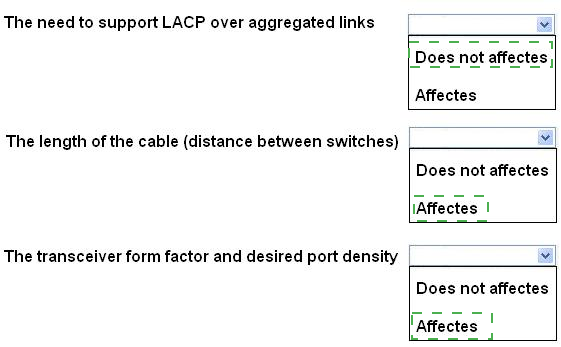
Explanation:
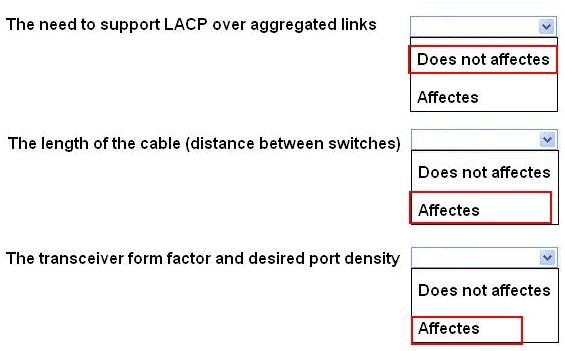
C:\Documents and Settings\David\Desktop\1.jpg